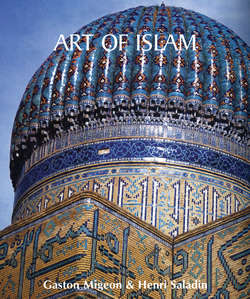Читать книгу Art of Islam - Gaston Migeon - Страница 2
Introduction
ОглавлениеWithin a century, the Arab conquests that spread rapidly into the East, North Africa and Spain upset the social fabric of all the subjugated peoples by imposing not only a new religion and organisation, but also new customs and practices. One religion alone orchestrated the spread of a single statute. Although still reeling in the aftermath of barbarian conquests and torn by sectarian conflicts among Christians, the ruined former Roman provinces became the cradle of a new world, the Muslim world, which for centuries was more civilised than most countries in Europe. Since Muhammad had promised his followers that they would possess the kingdoms of the world, the enjoyment of material things was viewed as a gift and a reward, not as a despicable pleasure to be shunned by the faithful. Consequently, Muslim leaders sought to surround themselves with luxury and decorated their cities and palaces. The ostentation of caliphs became proverbial, and throughout their empire imposing monuments sprang up whose opulence and elegance remained legendary in the East.
The Muslim civilisation, forged by the efforts of many different people, was not composed solely of Arabs. Consistent with the models that influenced it and the places where it grew, it also included Greeks, Persians, Syrians, Egyptians, Spaniards and Indians. Considering all origins together, however, Arabs, although never so far accurately defined, unquestionably made up the greatest number. This background notwithstanding, they were able to fuse these greatly diverse elements into one homogeneous blend and build a civilisation that bears the mark of their genius. The art of Felix Arabia, ancient Yemen, cannot be left out of a list of countries that influenced early Islamic art. The primary result of Islamic conquests was a kind of blend of Eastern and Western artistic traditions.
This vast Muslim world, whose pilgrimages to Mecca reflected the nomadic nature of their culture, made persistent efforts towards unification, transmission and mixing of the various traditions in their empire, resulting in a constant evolution of the arts. During periods of peace, the pilgrimage, obligatory for every faithful Muslim, brought together people from various countries. Naturally, people of the same trade preferred to meet together and interact with one another. The trip to Mecca was long and expensive for craftsmen from far-flung countries, and the poorest had to stop and work along the way in order to obtain the necessary resources. During such relatively long stays in the cities, the most assiduous could learn construction techniques and manufacturing skills. Upon returning home, they would try to imitate the new techniques they had seen.
Consequently, the rich and powerful Muslim world established a considerable trade system throughout the Mediterranean, along caravan routes, the Red Sea, and the Persian Gulf. During long periods of peace, under the great caliphs, the luxury and wealth of individuals facilitated trade. Immense bazaars were set up in every big city, and caravansaries appeared even in the middle of deserts. Islamic maritime art rivalled that of the Byzantine Empire or Italy. This situation was very advantageous to the renewal and proliferation of artistic techniques. The distinction between the splendour of the early centuries of Islam and the barbarism of the Christian world until the crusades is extraordinary.
